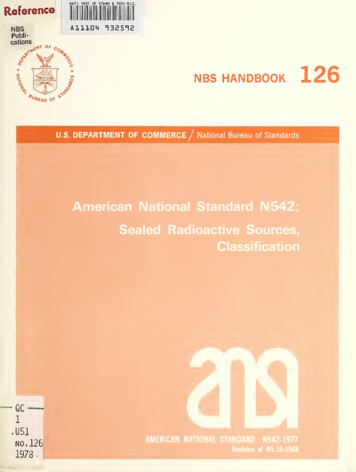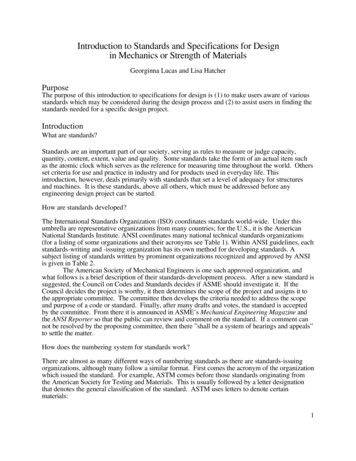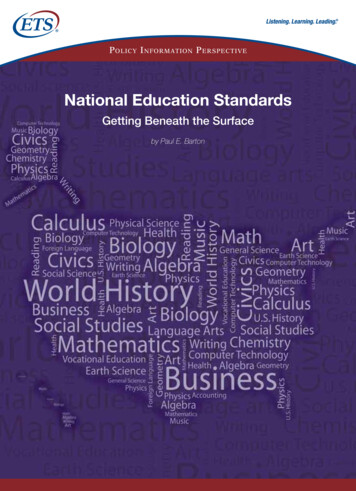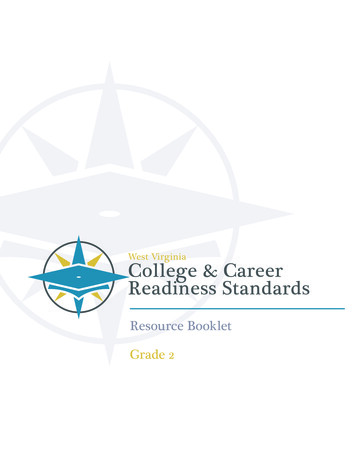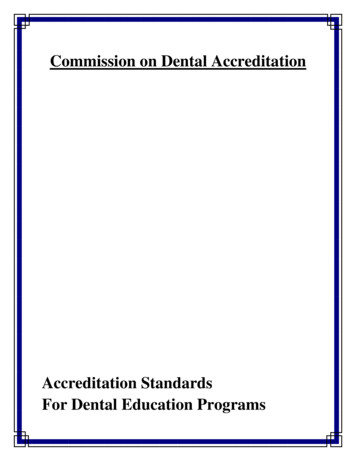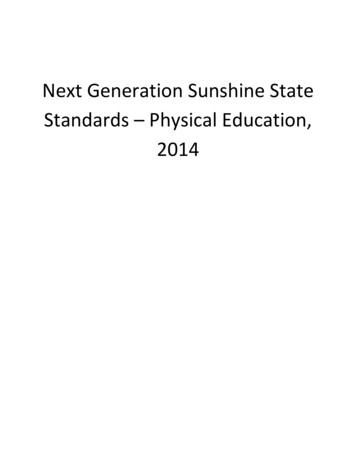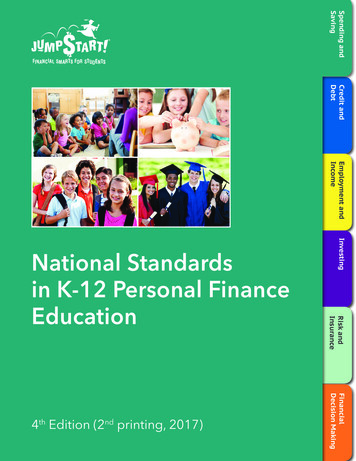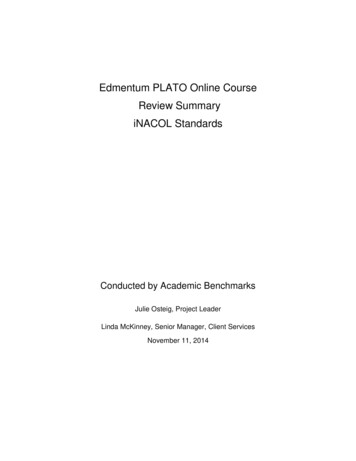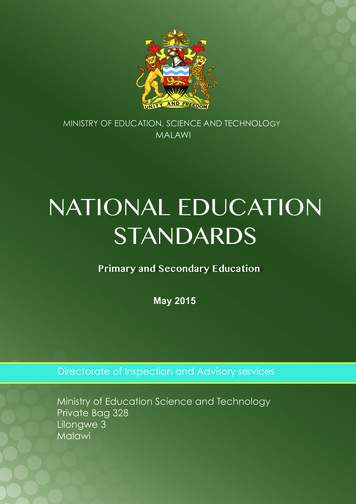
Transcription
MINISTRY OF EDUCATION, SCIENCE AND TECHNOLOGYMALAWINATIONAL EDUCATIONSTANDARDSPrimary and Secondary EducationMay 2015Directorate of Inspection and Advisory servicesMinistry of Education Science and TechnologyPrivate Bag 328Lilongwe 3Malawi
Copyright: 2015 Ministry of Education, Science and Technology,Private Bag 328, Lilongwe 3 Malawi. All Rights Reserved
CONTENTSCONTENTSForeword .IIPreface .IIIAcknowledgements.VIntroduction.6How the National Education Standards are organised .7Leadership and management. 10Using the Education Standards.11Making judgements against the Education Standards. 12The National Education Standards.14Education Standard 1: Learning in lessons.15Education Standard 2. Students’ outcomes in the curriculum. 16Education Standard 3: Attainment across the school. 17Education Standard 4: Students’ participation in education. 19Education Standard 5: Students’ behaviour and involvement in school life. 20Education Standard 6: Students’ safety and protection. 21Education Standard 7: A curriculum which is appropriate and relevant. 22Education Standard 8: High expectations. 23Education Standard 9: Teachers with good knowledge. 24Education Standard 10: Well-planned lessons. 25Education Standard 11: Teaching for effective learning. 26Education Standard 12: Accurate and constructive use of assessment. 27Education Standard 13: Teaching which meets the needs of all students. 28Education Standard 14: Effective management of behaviour. 30Education Standard 15: School vision, goals and values. 31Education Standard 16: School self-evaluation and improvement. 32Education Standard 17: School governance. 33Education Standard 18: School leadership. 34Education Standard 19: Partnership with parents and the community. 35Education Standard 20: Staff supervision and development. 36Education Standard 21: Staff deployment and management. 37Education Standard 22: Care and welfare of students. 38Education Standard 23: Access, equity and inclusion. 39Education Standard 24: Management of buildings and facilities. 40Education Standard 25: Management of material resources. 41Education Standard 26: Financial management. 42I
NATIONAL EDUCATION STANDARDSFOREWORDThe Ministry of Education Science and Technology has a mandate under the EducationAct 2013 (Section 4) to set and maintain national education standards. This publicationpresents for the first time an agreed set of National Education Standards for Malawi.These Standards specify expected outcomes for students which should be delivered byall education providers in public and private institutions. They also identify the leadership,management and teaching processes which are essential to the achievement of theoutcomes.The Standards articulate clearly the educational experiences and achievements whichkey stakeholders, in particular students and their parents and carers, should expect theirown schools to deliver. Finally, the publication demonstrates how the success of schoolsin achieving these outcomes for their students should be measured.My Ministry is sharing these Standards with the education sector and its key stakeholdersin a spirit of openness and transparency and to support the processes of schoolimprovement. The Standards are presented in the form of minimum requirements foreducational provision and practice. All schools should implement these requirementsin order to promote equality of educational opportunity and remove barriers toachievement. In this way, the overall quality of education will improve and theknowledge and skills of the general population increase across the country. Youngpeople will be better prepared for their roles as industrious citizens, parents and workersand make more effective contributions to national development.To this end, the standards are aligned to the Malawi Growth and Development StrategyII (MGDS II) and the National Education Sector Plan 2008 - 2017. They take into accountthe goals and objectives of education in Malawi and the guiding principles of accessand equity, quality and relevance and governance and management in all educationsubsectors.In addition to stipulating minimum requirements expected of all schools, the Standardsspecify targets for effective practice which are both challenging and achievable. Thesetargets should inform the development of school improvement plans. They should also bepoints of reference for the work of policy makers, development partners and educationagencies as they drive forward educational change and reform across the country.It is the responsibility of education administrators and advisory services in divisions anddistricts to explain, interpret and exemplify the Standards to education practitionersand civil society within their individual contexts, across all sectors and at all levels in thesystem.The specification of Standards enables more accurate and comprehensive reportingon the quality of education than has been possible in the past. The Directorate ofInspection and Advisory Services has a duty under the Act to measure compliance withthe Standards. It will report to the Ministry on the extent to which the Standards are beingimplemented and on the overall quality of education. The Ministry and all its Directoratesare committed to supporting the implementation of the National Education Standards,to ensuring openness and transparency in reporting and to contributing to improvementsin the quality of education provision across the country.I sincerely wish to thank all stakeholders who, through several consultations, havecontributed to the development of the National Education Standards.Emmanuel Fabiano, PhDMinister of Education Science and TechnologyII
NATIONAL EDUCATION STANDARDSPREFACEThe National Education Standards have been developed to support thework of all those who are striving to improve the educational achievement ofstudents in Malawi. The Education Act 2013 summarises the knowledge, skills andcompetences which young people must acquire in order to lead productive,fulfilling and successful lives as they continue their education, enter the workforceand assume their civil responsibilities. All students in Malawi have the right to aneducation which at least meets minimum standards and which enables themto achieve the outcomes they need to build on their skills and provide for theirfamilies. These outcomes are expressed in Sections 4 and 5 of the Act as twelveeducational goals. These goals inform both the content and the spirit of theStandards.The aim of the Standards is to specify both minimum requirements and whatconstitutes effective practice in educational provision and practice, for use inevaluation at a number of levels and in a range of contexts. For example: inspectors will use the Standards in their planned evaluation and reportingon school quality across the country; advisory services will use the standards to monitor the production andimplementation of school improvement plans, to supervise the work ofeducation practitioners and to provide the necessary support; schools shall use the Standards to identify areas where improvement isneeded and build the necessary action into their improvement plans; and national agencies, development partners and civil society organisationsare advised to use the Standards to contextualise and plan their support foreducation within the context of national, district and school improvementplans.In summary, the purpose of the Standards is to: aid policy makers at national, divisional and district level in the evaluationof the effectiveness of education in their area and across the country as awhole; and guide individual institutions and practitioners in reviewing and improvingtheir practice.Over recent years, the focus of educational reform has increasingly shifted fromanalysis of school inputs such as grants allocated, curriculum documentationproduced, pupil-teacher ratios, and teacher qualifications, to evaluation ofeducational outcomes, such as the quality of learning and the extent of studentachievement, including graduation rates, and drop- out rates.This set of Standards has been produced by the Ministry of Education Science andTechnology through rationalising and harmonising existing approaches, bringingthem in line with current approaches to educational evaluation and consultingwith practitioners in the field through a process of validation.In their final form, use of the Standards will focus on the achievement of threestrategic outcomes: improved performance of students at primary, secondaryand teacher education levels; improved teaching at primary, secondary andteacher education levels and improved leadership and management at primary,secondary and teacher education levels.These strategic outcomes provide a framework which both guides schoolimprovement in accordance with stakeholders’ needs and fulfils the MOEST’smandate to promote education standards of the highest quality.This set of National Education Standards relates to the work of schools andeducational settings which are directly responsible for students’ learning. In duecourse, two further sets of standards will be produced:III
NATIONAL EDUCATION STANDARDS for colleges of teacher education; and for national and district support services.The three sets of standards will complement each other and make asignificant contribution to raising standards of teaching and learning acrossthe country.Lastly I wish to request the support and continued commitment from MOESTdirectorates, Malawi Institute of Education (MIE), Malawi National ExaminationsBoard (MANEB), Malawi National Library Services (MNLS), our DevelopmentPartners, and all other stakeholders in effective implementation of theStandards. DIAS, in particular, should intensify its commitment to evaluatingand maintaining standards in our education institutions.Lonely V. Magreta (Mrs)Secretary for Education Science and TechnologyIV
NATIONAL EDUCATION STANDARDSACKNOWLEDGEMENTSThe development of the National Education Standards has been the resultof collaboration by MOEST and its key stakeholders. The MOEST thereforewishes to thank senior policy makers for providing strategic direction and theDirectorate of Inspection and Advisory Services (DIAS) for playing a key role inthe development and production of the standards. The Ministry of Education,Science and Technology (MOEST) would like to express its profound gratitudeto all development partners, in particular GIZ, the Scottish Government, UNICEFand Link Community Development for the technical and financial supporttowards the development of these standards. Special gratitude goes toEducation Division Managers, District Education Managers, Headteachers andteachers for providing constructive contributions towards the development ofthese standards. The process of developing National Education Standards alsobenefitted a lot from the contributions made through the Standards, Researchand Development Technical Working Group.V
NATIONAL EDUCATION STANDARDSINTRODUCTIONINTRODUCTIONThe aim of this set of National Education Standards is to set down expectations ofeducation quality in important aspects of school education in Malawi. The Standardsencompass key features of effective leadership, management and teaching andidentify expected outcomes for students.In particular, the National Education Standards identify minimum requirements whichall schools in Malawi should aim to achieve. Schools should focus on those areas ofweakness identified through use of the Standards and improve them through theschool improvement planning process. Where schools already meet the minimumrequirements set down, they should aim to improve their provision and practice bybuilding on their strengths and taking further action for improvement with the aim ofbecoming a fully effective school.The Standards derive from work carried out by the Directorate of Inspection andAdvisory Services (DIAS) over some time and take into account good practice inevaluation within other organisations and contexts.Legal and policy contextLegal and policy contextThe Standards have been set in accordance with The Constitution of the Republic ofMalawi Section 25 which stipulates that every person is entitled to education and thatthe schools or institutions offering education should be maintained according to officialstandards.The Education Act Section 4(c) stipulates that it shall be the duty of the Minister to setand maintain national education standards.Target audienceThe Standards are for use by the following groups of people. Headteachers and school staff in primary and secondary schools; Members of governing bodies, school management committees, parent/teacherassociations and parents and community members more generally; Local government officials; Advisers and Inspectors from DIAS; Ministry officials working in other Directorates; Education specialists working in partner organisations and in international andnon-governmental organisations; and Members of associations for headteachers and other education professionals.The Standard may be used toThe Standards may be used to: identify areas of focus for supervision and the provision of advisory support, schoolself-evaluation, school performance review and inspection; provide topics for discussion at meetings with students, parents and staff; select priorities for improvement to include in school or district improvement plans: inform the training of education professionals at all levels within the system; provide advice about educational priorities for a range of audiences;6
NATIONAL EDUCATION STANDARDS evaluate, monitor and report on the quality of education in individual schools, withinlocal areas and across the country as a whole; encourage consistent, valid and reliable approaches to evaluation among educationprofessionals working at all levels, locally and nationally; and foster partnerships among education stakeholders.HowtheNationalEducationStandardsare organisedHowtheNationalEducationStandardsare organisedThere are three groups of standards, those relating to: the outcomes which all students should achieve as a result of being educated inschool; the key aspects of the teaching process which lead to students achieving theseoutcomes; and the leadership and management processes which need to function effectively forgood teaching and learning to take place.In other words, the three-part structure within which the Standards are organised isdynamic and causal. The structure also relates to the responsibilities members of theschool community have for school quality.School leaders are responsible for ensuring that the teaching staff do a good job.Teachers are responsible for ensuring that students achieve the outcomes they should.Outcomes for students.The outcomes which we expect students to achieve as a result of attending school focuson different aspects of their school experience. Here are the six outcomes which havebeen identified as important indicators of success.7
NATIONAL EDUCATION STANDARDSAREAOutcomes for studentsLearning inlessonsStudents’ outcomesin the curriculumAttainment acrossthe schoolStudents’participation ineducationNO123456EDUCATION STANDARDLearning in lessonsStudents’ outcomes in the curriculumAttainment across the schoolStudents’ participation in educationStudents’ behaviour and involvement in school lifeStudents’ safety and protectionThis Standard relates to students’ active engagement in thelearning process while they are in class. With good teaching, evenchildren who may not do well enough to pass examinations canstill improve their skills, particularly literacy, numeracy and socialskills. Such skills are important for parenthood and employability.Teachers are responsible for helping all children in their class tolearn, not just the most able. This Standard looks at the quality ofchildren’s learning and the extent to which they are acquiring thekinds of skills they need to carry on learning in later life.This Standard relates to students’ achievements as measuredby their mastery of the learning outcomes set down in thenational curriculum. It measures the extent to which studentsare achieving at the expected level for their stage, usingquantitative measures relating to their achievement of thespecified learning outcomes.This Standard measures the effectiveness of the schoolin achieving positive outcomes for all its students. It usesstatistical measures such as examination results. Thesemeasures should be analysed in the context of the successof the school in ensuring that its students complete theeducation on which they have embarked (see below).This Standard measures the school’s effectiveness inensuring that its students gain as much from their schoolexperiences as possible by attending for the full number ofyears. It uses statistical measures such as the proportion ofstudents who repeat classes or complete their education.8
NATIONAL EDUCATION STANDARDSStudents’ behaviourand involvement inschool lifeStudents’ safetyand protectionThis Standard measures the extent to which students havedeveloped important social skills as a result of their schooleducation. Good behaviour is not passive. In fact, theStandard measures the extent to which all students aredeveloping into self-disciplined responsible young people,who are benefiting from opportunities to express theirviews and take responsibility for aspects of their currentand future lives.This Standard measures the school’s effectiveness inkeeping its students safe from abuse and harm of differentkinds, for example, physical, sexual or emotional abuse. Itdeals with the success or otherwise of the school’s actionsto ensure that all learners are included in the experiencesit offers.This group of Standards is the most important of the suite of twenty six as outcome indicators are the ultimate measures of the success of the school. Schools exist in order for youngpeople to learn and achieve. This set of six Standards aims to measure the extent to whichstudents are actually benefiting from being at school.The teaching processThe teaching processThese Standards identify the key factors which contribute to effective teaching. Effectiveteaching brings about effective learning and the achievements which are described in theprevious section.The teaching process7891011121314A curriculum which is appropriate and relevantHigh expectationsTeachers with good professional, subject and curriculum knowledgeWell-planned lessonsTeaching for effective learningAccurate and constructive use of assessmentTeaching which meets the needs of all studentsEffective management of behaviour9
NATIONAL EDUCATION STANDARDSThese eight Standards reflect the key skills involved in teaching. The Standardsare not designed to be used to judge the work of an individual teacher. That is therole of the Performance Appraisal system. Nor are they to be used to evaluate thedelivery of an individual lesson. The Standards instead look at teaching across theschool as it is delivered by the body of teachers who comprise the school staff.The Standards specify expectations of key activities such as lesson planning, lessondelivery and assessment. The Standards also include reference to the effectivenessof teachers’ management of behaviour. If students do not behave well, they areunlikely to learn effectively. However, if the teaching is poor and does not interestand engage the students, then they are unlikely to behave well. The behaviour ofstudents may relate more to the quality of teaching and the care teachers showfor students than to the application of formal controls like school rules. Effectiveteaching and good relationships result in positive outcomes for ementThis group of twelve Standards is subdivided into two groups: Leadership andManagement.Leadership15161718Vision, goals and valuesSchool self-evaluation and improvementSchool governanceSchool leadershipThe Leadership Standards focus on the roles of the School Management Committee,Board of Governors, proprietors of private schools, headteacher and senior staff inensuring that students benefit from good teaching and are safe and well cared forin school. These standards also look at the extent to which the school communityhas a clear sense of direction and shares a common set of values. Often the schoolvision is simply a piece of paper on the wall of the headteacher’s office. However, avision that reflects important priorities which have been chosen and shaped by theschool community should be a powerful force for improving the quality of rship with parents and the communityStaff supervision and developmentStaff deployment and managementCare and welfare of studentsAccess, equity and inclusionManagement of buildings and facilitiesManagement of material resourcesFinancial management10
NATIONAL EDUCATION STANDARDSThe Management Standards focus on the practical action the school takes to ensurethat all students have a positive school experience, that they are safe, happy andlearning well. This action includes working with parents and the community aswell as managing and supporting staff. Efficient and effective use of the resourcesavailable is essential for the school to operate equitably and in the interests of allthe young people it StandardsSchool practitioners and managers are NOT expected to work through all theStandards at once. Rather they should select a small group of specific Standardswhich focus on key aspects of students’ outcomes, the teaching process andleadership and management. They should use these standards to identify areas forimprovement to include in their school improvement plans.Inspectors and advisers will also select an appropriate number of Standards toshape and inform their work in inspecting, monitoring, evaluating and reporting onquality and in providing support and challenge to schools and districts.Standard 16 School self-evaluation and improvement, in particular, will be at theheart of the work of Primary and Secondary Education Advisers and inform thesupport and monitoring they provide to schools at different stages of the schoolimprovement cycle: following up inspections, identifying improvement targets,monitoring the school’s progress in taking the necessary action and evaluatingwhether the school has achieved what it set out to do.The Education Standards are presented at four Levels of Achievement.Level 4: EffectivePracticeThe requirements at Level 4 are intended to be both aspirational and achievable. They should provide manageable targets forschools to aim for as well as clear expectations for the quality ofeducation which it is hoped that all schools in Malawi will eventually achieve. Schools which achieve Level 4 may be used as models of good practice for other schools to emulate.Level 3: ExceedsLevel 3 identifies some of the key processes and activities typicalMinimum Standards of practice which is better than the minimum standard. Schoolswhich have achieved the basic requirements of Level 2 may referto the requirements within Level 3 in order to identify targets fortheir school improvement plan.Level 2: MeetsLevel 2 presents the basic requirements expected of all schools inMinimum Standards Malawi in each of the twenty-six Standards.Level 1: BelowLevel 1 relates to those schools which fail to achieve the requireMinimum Standards ments of an adequate education for their students in one or morerespects. Such schools should make immediate plans for improvement so that the experiences and achievements of young peopleare not further damaged. It is likely that schools which demonstrate practice at Level 1 in one or more Standard will need thesupport and guidance of a Primary or Secondary Education Adviserto help them plan for improvement. The Adviser can further helpthe school by monitoring progress on the plan and giving professional advice as necessary.11
NATIONAL EDUCATION STANDARDSMakingjudgementsagainstthe EducationStandardsMakingjudgementsagainstthe EducationStandardsWhen using the Standards in evaluation, it is recommended that evaluators lookfirst at Level 2, in order to judge whether the school is meeting the minimumstandards expected of all schools in Malawi. Schools which do not meet all thebasic requirements of Level 2 would be rated at Level 1, Below Minimum Standardsin the specific aspects selected. Schools evaluated at Level 1 should work towardsimproving the areas of weakness through the school improvement planning process.Those schools which meet all the minimum requirements of Level 2 should bejudged also against the requirements for Level 3. If these schools meet all therequirements for Level 3 as well as those for Level 2, they can be judged as beingat Level 3, Exceeds Minimum Standards.Where schools demonstrate performance which encompasses all the requirementsidentified as Effective Practice, as well as the requirements for Levels 2 and 3,they should be evaluated as being at Level 4 in that Standard.The requirements for three of the Outcome Standards (Standard 2: Students’outcomes in the curriculum, Standard 3: Attainment across the school andStandard 4: Participation in education) are expressed in quantitative language(i.e. statistically) rather than in the more qualitative terminology used for therest of the Standards. This is because the nature of the judgements in these threeStandards is different from those made in the other twenty-three Standards. Thedifference comes about because the judgements are made against national criteria:achievement of learning outcomes in national curriculum guidelines, averages andtargets for performance in national examinations and completion and repetition.These Standards can be used to measure progress against the specific quantifiabletargets of the Education Sector Implementation Plan (ESIP).The overall approach to evaluation outlined above is designed to be used forindividual Standards. It is NOT designed to be used to average evaluations acrossmore than one Standard.Using the Standards to improve the quality of school educationUsing the Standards to improve the quality of school educationAll education agencies, partners and providers are charged with providingeducation of the highest quality possible, or with contributing to that processthrough improvement activities in individual schools or across the country asa whole. Through the complementary work of its inspectors and advisers, theDirectorate of Inspection and Advisory Services is responsible for evaluating theextent to which schools in individual districts and across the country meet therequired standards.Schools which fall below minimum standards are damaging the futures of thechildren they are set up to serve. Immediate improvements are needed in thesecircumstances and the targets and timescales of school improvements plans shouldbe adjusted accordingly. Advisory services will provide support for development andmonitor the progress of schools in improving their provision and practice, for the12
NATIONAL EDUCATION STANDARDSbenefit of their students. Through follow-up inspections and reviews, advisers andinspectors will also judge the extent to which school improvement targets have beenmet and students’ learning and care have got better.In those school where little improvement has been achieved, action will be takenat district, divisional or, if necessary, at national level to ensure that the damageto children’s education is halted and addressed. The Directorate of Inspection andAdvisory Services will report to the Minister of Education Science and Technology andwork with partner Directorates to ensure that the necessary action is taken and thatimmediate improvements to children’s learning and care are made and their impactobserved.13
NATIONAL EDUCATION STANDARDSThe National Education StandardsAREAOutcomes forstudentsNO123456The teaching process 789LeadershipManagementEDUCATION STANDARDLearning in lessonsStudents’ outcomes in the curriculumAttainment across the schoolStudents’ participation in educationStudents’ behaviour and involvement in school lifeStudents’ safety and protection1011121314A curriculum which is appropriate and relevantHigh expectationsTeachers with good professional, subject and curriculumknowledgeWell-planned lessonsTeaching for effective learningAccurate and constructive use of assessmentTeaching which meets the needs of all studentsEffec
The National Education Standards . Education Standard 1: Learning in lessons . The Ministry of Education Science and Technology has a mandate under the Education Act 2013 (Section 4) to set and maintain national education standards. This publication

